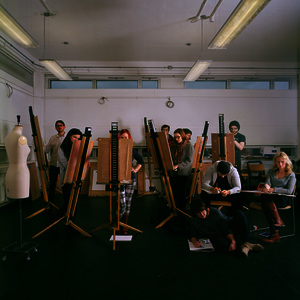Tierney, Daniel  ORCID: 0000-0002-0379-5107
(2015)
Life Drawing.
[Image]
ORCID: 0000-0002-0379-5107
(2015)
Life Drawing.
[Image]
![[thumbnail of Life Drawing Final Image]](https://clok.uclan.ac.uk/17752/1.hassmallThumbnailVersion/Life-Drawing_03-Edit.jpg)  Preview |
Image (JPEG) (Life Drawing Final Image)
- Published Version
Available under License Creative Commons Attribution Non-commercial. 654kB |
Official URL: http://www.danieltierney.co.uk/
Abstract
By subtly referencing Velazquez’s 17th Century classical painting Las Meninas, the image explores issues of representation and indexicality within the artwork. By positioning the focal plane of the camera in the same position as the sitter, parallels can be drawn between the painterly aspects drawn by the subjects and the photographic representation directed towards the viewer. These representations, each left concealed to both subject and spectator, mirror the other’s perspective and highlight the ambiguity of the artwork’s ontology. By diverting the gaze back towards the viewer, the nature of this construction becomes apparent.
Life Drawing attempts to highlight the work employed outside the image through the artwork itself. But rather than physically dismantling the ontological framework, the idea here is to reflect the component parts of the image’s construction. Though encountered later, Michel Foucault’s dissection of Las Meninas provides a perfect interpretation of the intentions of Life Drawing.
‘From the eyes of the painter to what he is observing there runs a compelling line that we, the onlookers, have no power of evading: it runs through the real picture and emerges from its surface to join the place from which we see the painter observing us; this dotted line reaches out to us ineluctably, and links us to the representation of the picture … this slender line of reciprocal visibility embraces a whole complex network of uncertainties, exchanges, and feints. The painter is turning his eyes towards us only in so far as we happen to occupy the same position as his subject. We, the spectators, are an additional factor. Though greeted by that gaze, we are also dismissed by it, replaced by that which was always there before we were: the model itself … in the neutral furrow of the gaze piercing at a right angle through the canvas, subject and object, the spectator and the model, reverse their roles infinity. And here the great canvas … exercises its second function: stubbornly invisible, it prevents the relation of these gazes from ever being discoverable or definitely established.’ (Foucault 1970:5)
Repository Staff Only: item control page

 Lists
Lists Lists
Lists
